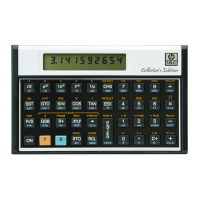Section 12: Calculating with Matrices 171
´ > 2
A 4 4
Transforms A
P
into Ã.
´ < C
A 4 4
Designates matrix C as
result matrix.
÷
C 4 1
Calculates X
P
and stores
in C.
| c
C 2 2
Transforms X
P
into X
C
.
l C
0.0372
Recalls c
11
.
l C
0.1311
Recalls c
12
.
l C
0.0437
Recalls c
21
.
l C
0.1543
Recalls c
22
.
´ U
0.1543
Deactivates User mode.
´ > 0
0.1543
Redimensions all
matrices to 0 × 0.
The currents, represented by the complex matrix X, can be derived from
C:
X =
I
1
I
2
=
0.0372+0.1311i
0.0437+0.1543i
.
Solving the matrix equation in the preceding example required 24
registers of matrix memory—16 for the 4 × 4 matrix A (which was
originally entered as a 4 × 2 matrix representing a 2 × 2 complex matrix),
and four each for the matrices B and C (each representing a 2 × 1 complex
matrix). (However, you would have used four fewer registers if the result
matrix were matrix B.) Note that since X and B are not restricted to be
vectors (that is, single-column matrices), X and B could have required
more memory.
The HP 15c contains sufficient memory to solve, using the method
described above, the complex matrix equation AX = B with X and B having
up to six columns if A is 2 × 2, or up to two columns if A is 3 × 3.
*
(The
allowable number of columns doubles if the constant matrix B is used as
the result matrix.) If X and B have more columns, or if A is 4 × 4, you can
solve the equation using the alternate method below. This method differs
from the preceding one in that it involves separate inversion and
multiplication operations and fewer registers.
*
If sufficient memory space is dimensioned to the common pool (W: 33 64 00-0 or
more). Refer to Appendix C, Memory Allocation.

